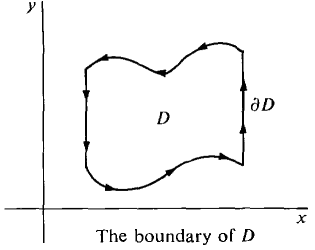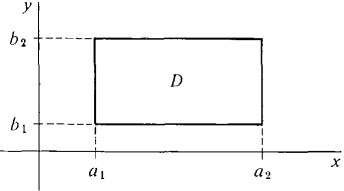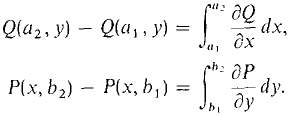| The ebook Elementary Calculus is based on material originally written by H.J. Keisler. For more information please read the copyright pages. |

|

Home  Vector Calculus Vector Calculus  Green's Theorem Green's Theorem  Green's Theorem Green's Theorem |
|






|
|
Green's Theorem
Green's Theorem gives a relationship between double integrals and line integrals. It is a two-dimensional analogue of the Fundamental Theorem of Calculus,
and shows that the line integral of F(x, y) around the boundary of a plane region D is equal to a certain double integral over D. Let D be a plane region a1 ≤ x ≤ a2, b1(x) ≤ y ≤ b2(x). The directed curve which goes around the boundary of D in the counterclockwise direction is denoted by ∂D and is called the boundary of D (Figure 13.4.1).
Figure 13.4.1 If b1(x) and b2(x) have continuous derivatives, ∂D will be a piecewise smooth curve and thus a simple closed curve (see Section 13.1). GREEN'S THEOREM Let P(x, y) and Q(x, y) be smooth functions on a region D with a piecewise smooth boundary. Then
(See Figure 13.4.2.)
Figure 13.4.2 The second formula follows at once from the first formula by replacing P by -Q and Q by P. We shall prove the theorem only in the simplest case, where D is a rectangle. PROOF FOR D A RECTANGLE D is shown in Figure 13.4.3.
Figure 13.4.3 The line integral around 3D is a sum of four partial integrals,
By the Fundamental Theorem of Calculus,
Therefore
We may apply Green's theorem to evaluate a line integral by double integration, or to evaluate a double integral by line integration.
|
|
Home  Vector Calculus Vector Calculus  Green's Theorem Green's Theorem  Green's Theorem Green's Theorem |
|
Last Update: 2006-11-25









